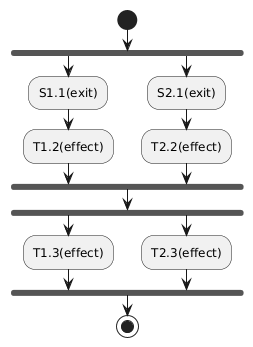Do the following steps form a single atomic step: firing a transition, the target state's entry behavior then completion?
E.g., in Test Transition 019 the 6th RTC step simultaneously fires T1.2 and T2.2 transitions from [S1[S1.1, S2.1]] configuration.
The traces show that which one of the parallel transitions (T1.2, T2.2) is fired first determines which target state (S1.2, S2.2) completes and puts completion event into the event pool first, because all traces are either:
- ..., T1.2(effect), ..., T2.2(effect), T1.3(effect), T2.3(effect) or
- ..., T2.2(effect), ..., T1.2(effect), T2.3(effect), T1.3(effect).
This would imply that all of the following is an atomic step and they cannot overlap with their counterparts in the other region: transition effect, entering the target state, state completion, putting CE(target) into the event pool. This rule is never mentioned in PSSM and it contradicts Test Entering 011 where ..., S1.2(entry), ..., S1.1(entry), ... trace order and CE(S1.1), CE(S1.2) completion event order are present.
I think the traces should be all the possible 12 execution order of this activity diagram.

This means that currently these 6 traces are missing, where the order of the last two effects is switched:
- S1.1(exit)::T1.2(effect)::S2.1(exit)::T2.2(effect)::T2.3(effect)::T1.3(effect)
- S1.1(exit)::S2.1(exit)::T1.2(effect)::T2.2(effect)::T2.3(effect)::T1.3(effect)
- S1.1(exit)::S2.1(exit)::T2.2(effect)::T1.2(effect)::T1.3(effect)::T2.3(effect)
- S2.1(exit)::S1.1(exit)::T2.2(effect)::T1.2(effect)::T1.3(effect)::T2.3(effect)
- S2.1(exit)::S1.1(exit)::T1.2(effect)::T2.2(effect)::T2.3(effect)::T1.3(effect)
- S2.1(exit)::T2.2(effect)::S1.1(exit)::T1.2(effect)::T1.3(effect)::T2.3(effect)
The atomicity problem is also present in:
- Entry 002-B, where fired transition order determines the order of entry behaviors and the order of CEs in the event pool,
- Terminate 001 and Terminate 002, where RTC steps transition order determines the order of entry behaviors and completion events.